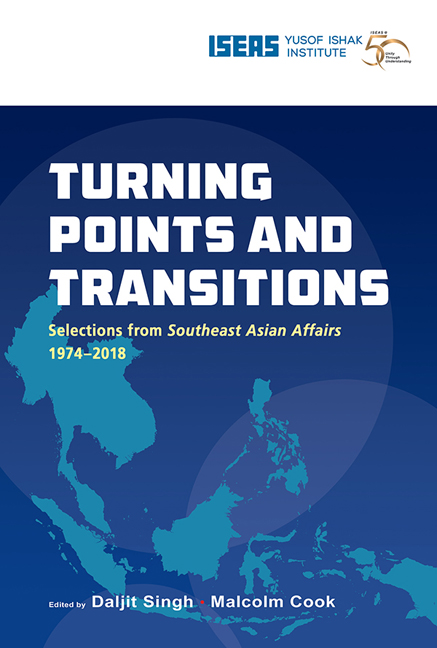Book contents
- Frontmatter
- Contents
- Message from the Director
- Foreword
- Foreword
- Introduction
- THE REGION
- BRUNEI
- CAMBODIA
- INDONESIA
- LAOS
- MALAYSIA
- MYANMAR
- Burma in 1988: Perestroika with a Military Face (1989)
- Myanmar 1990: New Era or Old (1991)
- Myanmar: No Turning Back (2012)
- Myanmar's General Election 2015: Change was the Name of the Game (2016)
- THE PHILIPPINES
- SINGAPORE
- THAILAND
- VIETNAM
Myanmar: No Turning Back (2012)
from MYANMAR
Published online by Cambridge University Press: 29 May 2019
- Frontmatter
- Contents
- Message from the Director
- Foreword
- Foreword
- Introduction
- THE REGION
- BRUNEI
- CAMBODIA
- INDONESIA
- LAOS
- MALAYSIA
- MYANMAR
- Burma in 1988: Perestroika with a Military Face (1989)
- Myanmar 1990: New Era or Old (1991)
- Myanmar: No Turning Back (2012)
- Myanmar's General Election 2015: Change was the Name of the Game (2016)
- THE PHILIPPINES
- SINGAPORE
- THAILAND
- VIETNAM
Summary
The year 2011 was one of change for Myanmar. It was the year of the country's administration becoming “civil” in the eyes of many in the country and the world at large. A civilian government, albeit with a military past, was sworn in on 30 March 2011. President Thein Sein's inaugural speech to the parliament, outlining priorities for economic renewal, sustainable development, poverty alleviation, human rights and good governance, and recognizing the plight of ethnic minorities involved in armed conflict, was initially dismissed by many as “just words”.
Six months later, however, observers within and outside the country were recognizing the steps outlined in this inaugural speech when changes started showing in Myanmar's political and economic scene. These changes include the freedom of movement (and speech) of Nobel laureate Aung San Suu Kyi, the loosened restrictions on the media, a law allowing workers the right to strike, amnesties for prisoners (including political prisoners), and steps taken towards economic reform. The pace set by the government on this road to reform seemed almost exhilarating to citizens and observers used to setbacks and stonewalling from the authorities in the past. The pace continued to surprise as 2011 progressed, peaking with the National League for Democracy (NLD) rejoining the political process, the agreement by the Association of Southeast Asian Nations (ASEAN) to Myanmar's bid to be the ASEAN Chair in 2014, and the landmark visit of U.S. Secretary of State Hillary Clinton to the country.
Indonesian Foreign Minister Marty Natalegawa has described the reform process in Myanmar as irreversible. Optimists and critics share concerns on whether the “flickers of progress” described by U.S. President Obama will develop into a steady flame. Having cited the reforms as a key reason for its decision to give Myanmar the ASEAN chair for 2014, ASEAN, too, has much at stake.
Reviewing developments in Myanmar in 2011, the picture that emerges shows the beginning of a convergence of interests, the first in decades, between the militarybacked government, the polity in Myanmar, the forces for democracy symbolized by Aung San Suu Kyi, and the international community.
The Year in Review
The year 2011 saw a newly elected “civilianized” government in Myanmar. It had come to power in what many around the world had largely decried as sham elections in November 2010.
- Type
- Chapter
- Information
- Turning Points and TransitionsSelections from Southeast Asian Affairs 1974-2018, pp. 507 - 519Publisher: ISEAS–Yusof Ishak InstitutePrint publication year: 2018

